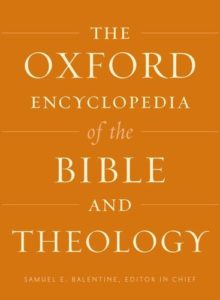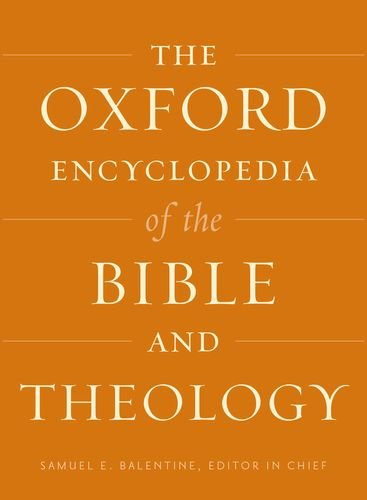 Oxford University Press has recently published The Oxford Encyclopedia of the Bible and Theology (OEBT), a two volume set that features a variety of articles (aprox. 164) on a host of persons, places, and subjects, all of which pertain to the Biblical books and their theological content.
Oxford University Press has recently published The Oxford Encyclopedia of the Bible and Theology (OEBT), a two volume set that features a variety of articles (aprox. 164) on a host of persons, places, and subjects, all of which pertain to the Biblical books and their theological content.
Summary
Any pastor, academic, or student of theology will be impressed with the list of contributors assembled for this project, as many of the authors comprise the foremost names in biblical and theological studies around the world. While not intending to be exhaustive, the OEBT seeks to elucidate biblical persons, places, and themes for their theological significance. This encyclopedia is therefore a reference work with a very particular aim–to thoroughly expound the theological significance of a particular set of central subjects, not to provide a brief definition an exhaustive list of subjects. Since this encyclopedia set covers a variety of subjects, it seems fitting to treat each subject separately as the means of evaluating the work as a whole.
Biblical Places
This is perhaps the smallest selection of articles in OEBT, as there are only six pieces written on the most prominent locations in biblical theology. The choice of ‘places’ reflects the theological intention behind the work as a whole, as ‘Eden’, ‘Heaven and Earth’, ‘Jerusalem’, and ‘Israel’ are all places with a significant theological import. For example, the article on ‘Eden’ by André LaCocque spills little ink over identifying a specific geographical location, but traces the use of Eden in Genesis 2-3, the other 13 references to Eden in the Old Testament, the notion of what Eden comes to represent in Jewish, Early Christian and Old Testament texts, and any discussion of Eden in Philo and Josephus.
Biblical Persons
One will find entries for the biblical figures that many scholars and students would expect to find in a bible encyclopedia (i.e. David, Abraham, Moses, John the Baptist, Paul). However there are a number of lesser expected entries such as the Holy Spirit, Mary, Trinity, and Angels. While ‘Jesus of Nazareth’ is not an article listed in OEBT, there are separate articles for ‘Christ’, ‘Lamb of God’, ‘Son of God/Man’, ‘Lord’, ‘The Last Adam’, and the ‘Servant of God’. Again, this reflects the theological purpose behind this work which seeks to identify the theological significance of persons and their titles by tracing ideological origins and examining various perspectives from within a wide collection of ancient texts.
Biblical Books
That particular articles on the biblical books themselves are not the central thrust of this work is evident from the fact that many of the biblical books are grouped together into larger sections. So for example, one will find an article upon the Catholic Epistles, the Deutero-Pauline Letters, The Book of the Twelve, the Megillot, etc. Therefore, if one is looking for an in depth and extensive article on the Epistle to the Hebrews, then OEBT may not be the researcher’s exclusive choice. Nevertheless, if there is interest in the major themes of Hebrews, such as ‘Covenant’, ‘Sacrifice and Offerings’, ‘Priests and Priesthood’, then OEBT should be a primary research tool for pastors, scholars, and students alike.
Biblical Themes
This subject area comprises the vast majority of articles found in the OEBT (over half the articles). Within this section the reader will notice articles on technical theological topics such as anthropology, soteriology, ecclesiology, reconciliation, etc. These articles are not reflections upon the history of interpretation, but an in-depth survey of the particular perspectives of the biblical writers on a given topic. So in the entry for ‘Soteriology’, Van der Watt traces the notion of salvation in the Synoptic Gospels, the Pauline literature, and the major contributions of the Catholic Epistles, noting any emphases and unique contributions. Another subgroup within the thematic articles considers the theological significance of various virtues and vices. These articles are extremely helpful when the pastor/researcher/student is studying a text that may center around the notion of love, joy, hope, anger, or peace. What are the particular Pauline emphases regarding the notion of peace? Is there a unified Old Testament concept of shalom? What nuances can the terms for peace have? Was there a dominant view of peace in other cultures (i.e. Hellenistic or ANE)? The final subgrouping within the thematic section are the biblical-theological topics. These topics include the concepts such as ‘flesh’, ‘body’, ‘Word’, ‘land’, ‘theophany’, ‘barrenness’, ‘exile’, etc. Many of these entries will have pan-biblical significance, as these concepts are traced through both the Old and New Testaments as well as any extra biblical developments that may have direct bearing upon the biblical perspective.
Evaluation
i) Breadth of Resources: Each article in OEBT seeks to situation the particular topic under discussion within the context of a vast catalog of primary source material. The reader will certainly benefit from the sheer amount of primary sources that are expounded in any one article, greatly aiding one’s own research and orientation to a subject.
ii) Combination of themes: Many of the thematic articles are a combination of themes that would normally be split up into separate articles. Some of these articles combine antithetical topics such as ‘Comfort and Mourning’, ‘Guilt and Innocence’, ‘Honor and Shame’ and ‘Reward and Retribution’. Other articles group related topics together into a single entry, such as ‘Idols and Idolatry’, ‘Exile and Dislocation’, ‘Story and Memory’, ‘Mercy and Compassion’, ‘Allegory and Typology’, and ‘Prophets and Prophecy’. This feature of OEBT results in an increased level of coherence and an overall balanced presentation. If articles are divided too finely, then relevant information will often be allocated to another article and the reader must hunt down the related theme. Hence, many readers have a fragmented and disrupted experience looking up a host of articles in dictionaries and encyclopedias. However OEBT’s approach will greatly limit this frustration as many articles are structured in order to provide relevant information upon the primary topic as well as the direct opposition theme or closely related themes.
iii) Thematic Finitude: Any project of this size will receive some criticism by way of certain omissions. Keeping in mind the overall concerns of the project (to provide a theological encyclopedia of significant biblical persons, places, books, and themes), any such criticism will largely be peripheral. Nevertheless, some will long for more detailed articles on the actual biblical books themselves, particularly as many books are grouped together into articles that address the various collections of biblical books. Moreover, any encyclopedia project will omit entries that some will consider to be the things of first importance. This difficulty can often be often be overcome by reading related articles. So if the reader is looking for an entry on the theological significance of the place ‘Babylon’, one will find the relevant details in ‘Exile and Dislocation’, ‘Revelation’, and ‘Prophet and Prophecy’.
It is vital that scholars, pastors and students of theology have a good collection of reference works on a wide variety of topics that center on the primary source material. The Oxford Encyclopedia of the Bible and Theology is a fine addition to this all-important section of the theologian’s library.

